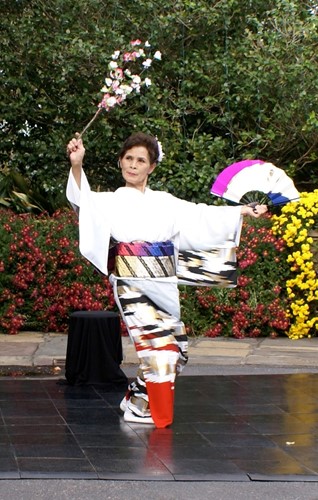Mitsuki (Miki) Farsky
Florida Folklife asked our artists a series of questions to learn more about their traditions and how those traditions have impacted their lives and the lives of those around them. Take a look at the answers we got from Mitsuki (Miki) Farsky below.
What folk tradition(s) or traditional art(s) do you practice?
Traditional Japanese dance; in particular, the traditional Japanese dance style known as, Nihon Buyo. Nihon Buyo did not reach its present form until 1868 (the Meiji Restoration). It uses a mixture of dance styles from the much older Kabuki and Noh dance traditions, as well as techniques from Japanese Folk dance, and western ballet.
How did you learn those traditions?
I became a student of Nihon Buyo during my teen years in my home town of Wajima, Japan, but it wasn’t until moving to the United States in 1971 that I began to perform, and instruct others in the art of traditional Japanese dance. Since then I have become a licensed instructor of the Sho No Ryu dance studio located in Tokyo Japan.
Why is it important to maintain folk traditions?
I think all folk traditions can also be considered as forms of art; and in art, as in life, it is variety that provides the spice. By preserving all these wonderful and various folk art traditions, we can make life that much more enjoyable and interesting, not just for those who practice the art, but, perhaps more importantly, for those who consume the art.
How did you first get involved with the Florida Folklife Program?
I was invited to participate in the 2011 Folklife program. It was a very gratifying, as well as a wonderful learning experience.
What Florida Folklife Program projects have you participated in and/or what folklife awards have you received?
[I participated in the] 2011 Florida Folklife Festival.
Other related (not Florida Folklife) programs I’ve participated in include:
November 2007, 2008, 2009, 2010, Panama City Fl, - Festival of Nations.
Aug 2009 - Birmingham, Al - Performance, Japan America Society event.
September, 2009 & 2010, Atlanta, Ga. - Japan Fest, a two day showcase of Japanese culture.
October, 2009, Panama City, Fl, Dance performed fund raiser to benefit the Junior Museum of Panama City.
March 2010, Panama City, Fl - Tokyo Nights II, a large scale production showcasing a variety of Japanese dance from the classic to the contemporary.
September 2011, Mobile, Al - Dance performance, Chrysanthemum Festival.
Apr 2011, Performance at Panama City Beach, Business Expo.
Mar 2011, Tallahassee, Fl - FSU cultural event.
Mar 2012, Pensacola, Fl. - UFW Cherry Blossoms Festival.
May 2012, Tallahassee, Fl - Perform for Big Bend Hospice fund raiser.
Mar 2016, Fort Walton, Fl - Classical Japanese Dance Performance.
Oct 2018, Pensacola, Fl. - Performance for Japan/US Military Program (JUMP) at National Naval Aviation Museum.
Jan 2019, Pensacola, Fl - Performance for Japan American Society (JAS) New Year’s celebration.
How has the Florida Folklife Program benefited you or what value does the program have?
The Florida Folklife Program has benefited me by providing an opportunity and a venue where I could share with others a different, and hopefully enjoyable aspect of the wonderful and diverse world of folk culture.
How can the Florida Folklife Program better serve you?
The Florida Folklife Program can best serve all those who have participated in, and/or attended your programs, by just continuing to do what you have been doing over the last 40 years. Just as in all performing and visual arts, the more we do it, the better we become at doing it. With each repetition we all learn something new, something that can make the next event even better. The Florida Folklife Program has contributed so much to preserving and showcasing a rich tapestry of cultural traditions that all Floridians can take pride in.

